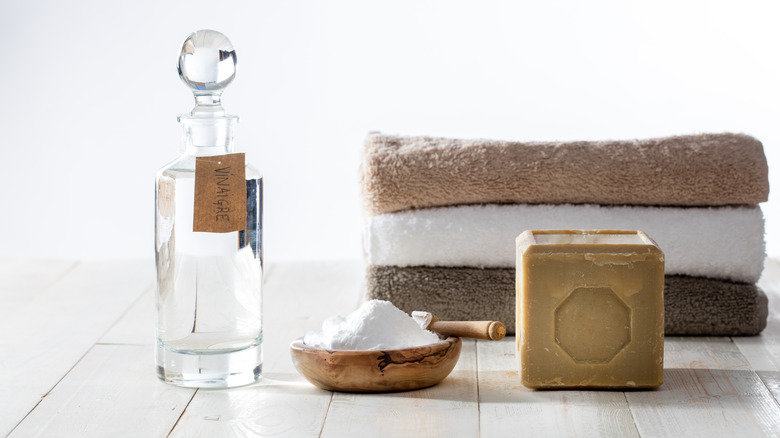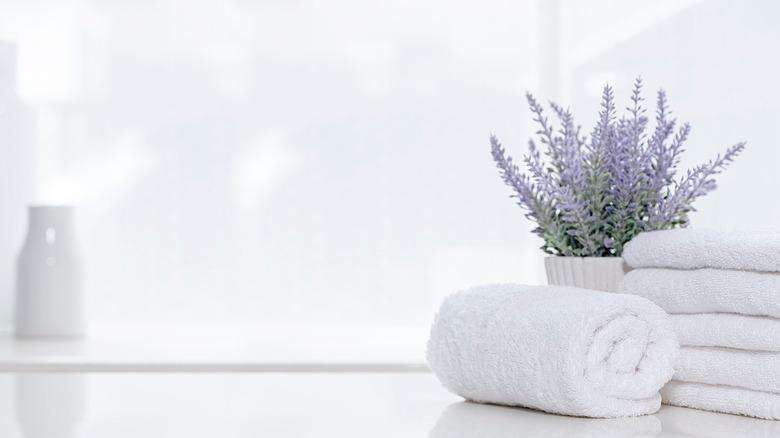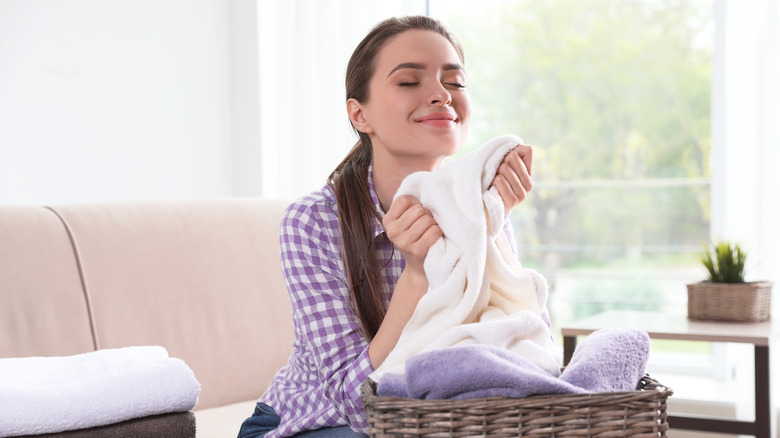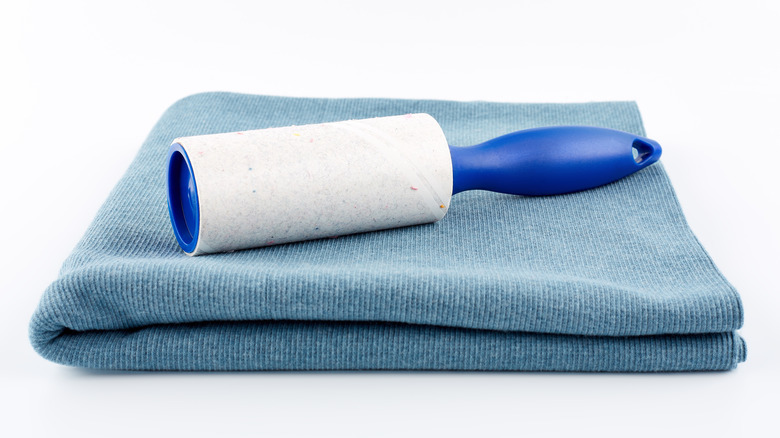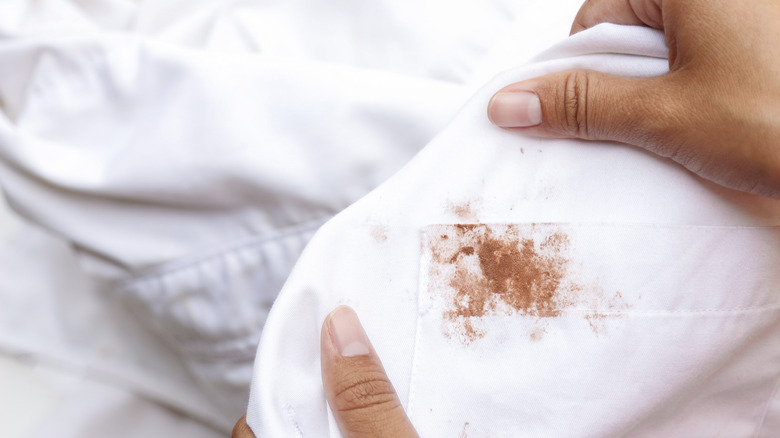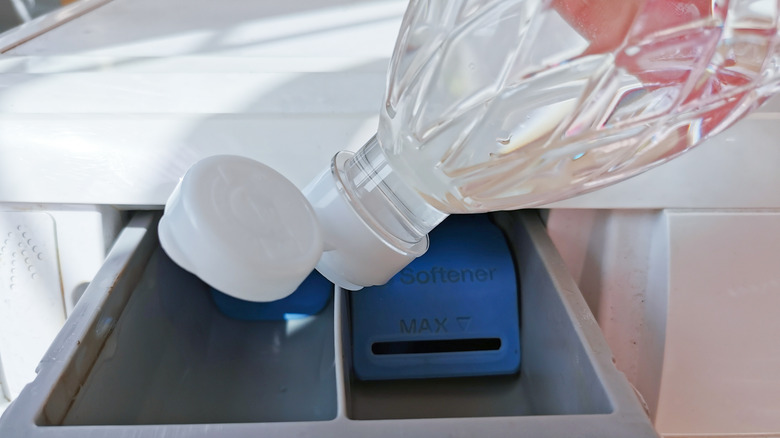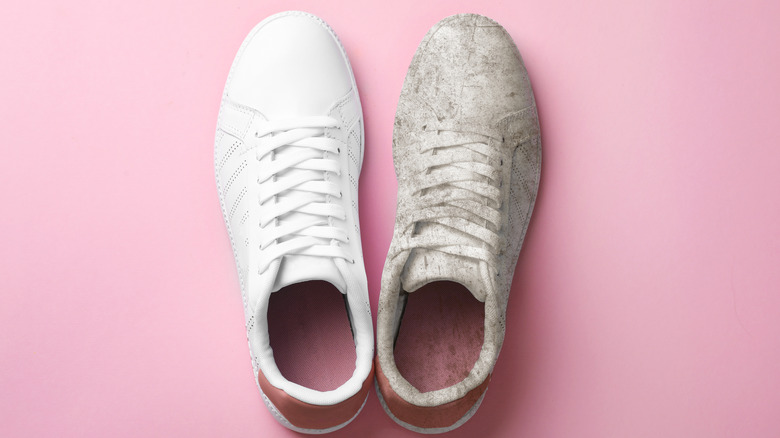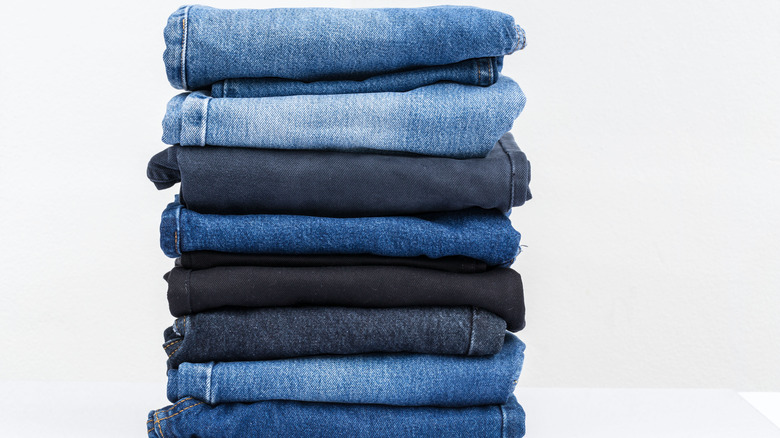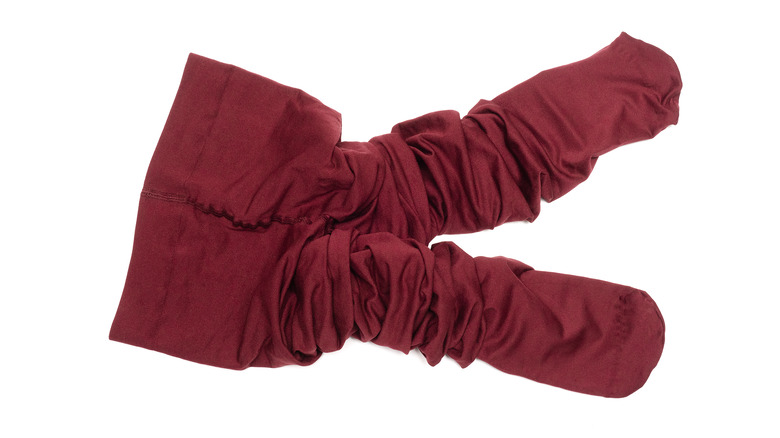10 Genius Tips For Using Vinegar In Your Laundry
White vinegar is one of those products that we honestly can't live without when it comes to cleaning the house. It is truly one of those items that we constantly stock in our pantries and cleaning supply closets. Vinegar has plenty of uses, including unclogging the kitchen sink, cleaning a faucet, banishing toilet stains, and ridding your bathroom of soap scum. But where it seriously shines is in the laundry room. "Vinegar is absolutely your secret weapon when it comes to redeeming difficult laundry quandaries," says Marilee Nelson, an environmental consultant and co-founder of Branch Basics, to Well+Good.
Here are 10 genius tips for using vinegar in the laundry room. We think you'll be amazed at what white vinegar can do for your fabrics. According to LoveToKnow, it can wash everything from white T-shirts to indigo denim to your shoes. It can even also help spruce up upholstery fabrics and carpeting. Read on for the best tips.
1. Make whites even brighter
There's nothing better than wearing a crisp, bright, white button-down shirt, but keeping it that way can certainly be a challenge after a few times wearing it. Your first instinct to whiten your dull white clothes may be to reach for the bleach. However, you may want to grab the distilled white vinegar instead. Apartment Therapy suggests taking a 1/2 cup of distilled white vinegar and mixing it with your regular detergent to get clothes to their brightest white. You can also attack stains with this mix, especially targeting those yellow underarm stains or food droppings on the front of shirts. The outlet says you can dry clothes in the sun, which can also help brighten them. (Plus, it will save energy!)
However, Better Homes & Gardens warns that you should never add chlorine bleach to distilled white vinegar since the combination can create fumes that are dangerous to breathe.
2. Get rid of that mildew smell
Let's say you have guests coming over, but the towels in your linen closet have an awful mildew smell. Don't panic! White vinegar can be an excellent option for removing nasty odors. Carolyn Forté, director of home appliances, cleaning products, and textiles at the Good Housekeeping Institute, told Today Home, "For high-efficiency top-loaders or front-loaders, I would just fill the fabric softener dispenser to the max level with vinegar so it is automatically dispensed in the final rinse. Otherwise, with these machines, there's no other way to add it at the correct time."
You can also add essential oil to your white vinegar for better smelling laundry. The Spruce recommends adding a few drops of lavender to the vinegar bottle, effectively eliminating mildew smells. If you don't like the scent of lavender, Real Simple suggests using another antibacterial oil, such as tea tree oil.
3. Make clothes feel softer
It turns out that distilled white vinegar can be an effective fabric softener, making clothes feel incredibly soft once they come out of the dryer. The Spruce suggests adding a 1/2 cup of vinegar during the last rinse cycle to achieve this. Be sure to specifically use distilled white vinegar and not apple cider vinegar because the latter could discolor your clothes.
In a Houzz debate about whether fabric softener or distilled white vinegar works best, one user made the switch to vinegar after seeing a noticeable difference in their towels. She shared, "We used to use fabric softener; then we switched to vinegar when a friend stayed over and commented on how hard it was to get dry with the towel we gave them to use. Now that we use vinegar, our towels are soft, and most importantly, they absorb so much better!" You can't argue with those kinds of results.
4. Eliminate excessive lint
Having excess lint show up on your fluffy towels and beautiful sweaters is always annoying, but luckily it's easily preventable. According to Apartment Therapy, distilled white vinegar will help eliminate that very dilemma. If you add a cup of white vinegar to the rinse cycle, you won't have to worry about fuzzy lint showing up on your clothes — which is all we need to know to start performing this essential laundry hack. Healthline also likes this hack. However, they suggest pouring 1/2 cup of vinegar instead of a full cup before the final rinse cycle. If you're unsure how much is right for your own laundry, experiment with the measurements and see which you like best.
Other ways to banish lint from your clothing include rubbing the clothes down with a dryer sheet, plucking the lint off by hand with masking tape, and washing your clothes inside out to minimize the amount of lint made.
5. Get rid of foul odors
Not only can white vinegar get rid of a mildew scent, but it can also get rid of other odors such as sweat or pet-related smells. Environmental Toxin Expert Tonya Harris, M.S. tells MindBodyGreen that you could skip the detergent altogether. Instead, she recommends adding 1/2 a cup of white distilled vinegar diluted with water to the laundry for a fresh scent. "Surprisingly enough, the strong scent of vinegar neutralizes odors, and the vinegar scent fades very quickly, leaving no scent behind," Harris says.
Hunker also suggests using white vinegar on stinky rugs or sofas. White vinegar can be added to a water bottle and lightly sprayed on carpeting and other upholstery to remove smells. This can be an excellent way to eliminate foul odors, such as when a pet has an accident on your favorite carpet. Let the carpet air dry and repeat the step if necessary.
6. Erase stains
Vinegar can be an excellent way to get rid of stains, including tricky grease splatter ones. While you may think your grease-stained clothes are a lost cause, Patric Richardson, host of HGTV's "The Laundry Guy," tells Better by Today that a mix of vinegar and water can work wonders on this type of stain. "Use a solution of 50 percent vinegar and 50 percent water on the stain," Richardson explains. Afterward, you can toss it into the washing machine and clean it with regular detergent and water. However, don't immediately throw it into the dryer. "DO NOT put the garment in the dryer until you have seen that the stain is gone."
If you have an ink stain, Molly Maid, a nationwide cleaning service, advises using a mixture of vinegar and cornstarch to attack the mark. Make a paste consisting of 2 parts vinegar, 3 parts cornstarch, and let it sit on the stain until it is dried. Rinse the paste off, and the blotch should be gone once you do a regular load of laundry.
7. Get rid of soap residue
Another reason to keep white vinegar on hand in the laundry room is to cut down on soap residue. Sammy Wang, a Tide senior scientist, told Martha Stewart, "Vinegar has a low pH (typically three to five), so it can help dissolve away residues that bind body soils to fabrics." However, Wang noted that white vinegar isn't more efficient when mixed with detergent, but rather when added during the last rinse cycle. "And using vinegar with your laundry detergent in the washing machine can decrease your laundry detergent's ability to clean away food stains by impacting cleaning ingredients called enzymes, so you may need to rewash the item," she explains.
Since it's an excellent natural option to get rid of soap scum or build-up, Kitchn suggests cleaning your washing machine with it. Run a rinse with vinegar to ensure your washer is functioning at its best.
8. Clean your shoes with a white vinegar and baking soda mixture
If you have an old pair of canvas shoes that have lost their luster, a white vinegar mixture can be a total game-changer. Woman's World suggests making a brightening paste by combining 1 tablespoon baking soda, 1 tablespoon white vinegar, and 1 tablespoon hot water. Once your paste is ready, grab a toothbrush (that you are done brushing your teeth with!) and begin scrubbing your shoes.
Let the paste penetrate the stains and set the shoes out in the sun to dry. Once the shoes are dry to the touch, scrub the dried paste off, and your sneakers should be sparkling white again. Since white vinegar also helps get rid of any foul odors, it can also help eliminate sweaty gym shoe smells that can easily penetrate an entire home. If you're dealing with suede shoes, The Family Handyman suggests using a microfiber cloth dipped in vinegar to gently rub the stains away.
9. Keep your denim from fading
Keeping denim from prematurely fading is a never-ending task. However, Byrdie claims that using vinegar during the jeans' first wash is the secret to keeping it fade-free. Suppose you have scored a pair of indigo jeans, and you're worried their color will fade after throwing them into the laundry. To avoid that from happening, Hunker recommends soaking your denim in a mixture of 2 quarts cold water, 1/2 cup salt, and 1/2 cup white vinegar for 2 hours. If dye comes out after rinsing your jeans from the mixture, soak the denim for another hour.
When it comes to washing the denim in the washing machine for the first time, Hunker recommends turning the pants inside out, putting the cycle on cold, adding 1 cup of white vinegar to the washing machine, and then laundering. Do not add detergent or softener to that first wash.
10. Wash your pantyhose
There is a lot to consider when washing pantyhose. They come in various colors, textures, materials, and thicknesses, which can make them tricky to launder. Do you wash them according to color, fabric, or level of delicateness? Luckily for us, we can take the guesswork out of washing hosiery by simply rinsing them in vinegar. LoveToKnow explains that you can wash delicates such as pantyhose with distilled white vinegar. It's not only a great way to eliminate unpleasant odors, but it also helps the fabric last longer.
According to The Laundress, an eco-conscious laundry brand, pre-washing pantyhose in white vinegar can help elongate its longevity and elasticity and help keep its color. You can soak your pantyhose in a sink or basin for 30 minutes in water mixed with 1/4 cup of vinegar. This will help refresh them. If your tights need a good scrubbing, it's best to hand wash them in tepid water with mild detergent.
